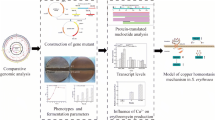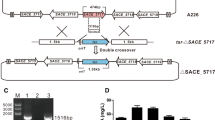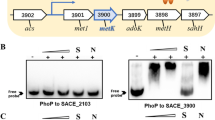Abstract
The MtrA-MtrB two-component regulatory system is highly conserved in Actinobacteria and plays crucial roles in cell cycle progression, cell morphology, antibiotic resistance, and osmoprotection. Previously, we revealed that the MtrA protein of Saccharopolyspora erythraea E3 strain (a high erythromycin-producing strain) had a two amino acid (H197 and V198) deletion in the DNA recognition helices of the C-terminal domain compared to the wild type S. erythraea strain NRRL2338. Here, we identified mepA (encoding a membrane protein related to metalloendopeptidases) as an MtrA target gene, and found that deleting the two amino acids in MtrA (MtrAdel) resulted in the loss of its DNA-binding activity for the mepA gene. The mutant MtrAdel lost its regulatory activity and affected various physiological functions consistent with mtrA deletion, including increased erythromycin biosynthesis, enhanced antibiotic resistance, deregulated osmoprotection, and improved transport of substances. The introduction of the wild type mtrA gene into the S. erythraea E3 strain with the mtrAdel gene decreased the erythromycin yield by approximately 50%, confirming that MtrA repressed erythromycin production. These findings demonstrate that MtrA is an important pleiotropic regulator of erythromycin biosynthesis, antibiotic resistance, osmoprotection, and substance transport in S. erythraea and provide new insights for improving erythromycin production. Future studies linking the molecular effects of MtrA to these phenotypes will improve our understanding of the MtrA-MtrB two-component regulatory system in Actinobacteria.






Similar content being viewed by others
References
Anderson TB, Brian P, Champness WC (2001) Genetic and transcriptional analysis of absA, an antibiotic gene cluster-linked two-component system that regulates multiple antibiotics in Streptomyces coelicolor. Mol Microbiol 39(3):553–566. https://doi.org/10.1046/j.1365-2958.2001.02240.x
Brocker M, Bott M (2006) Evidence for activator and repressor functions of the response regulator MtrA from Corynebacterium glutamicum. FEMS Microbiol Lett 264(2):205–212. https://doi.org/10.1111/j.1574-6968.2006.00456.x
Deretic V, Leveau JH, Mohr CD, Hibler NS (1992) In vitro phosphorylation of AlgR, a regulator of mucoidy in Pseudomonas aeruginosa, by a histidine protein kinase and effects of small phospho-donor molecules. Mol Microbiol 6(19):2761–2767
Fernandez-Martinez LT, Borsetto C, Gomez-Escribano JP, Bibb MJ, Al-Bassam MM, Chandra G, Bibb MJ (2014) New insights into chloramphenicol biosynthesis in Streptomyces venezuelae ATCC 10712. Antimicrob Agents Chemother 58(12):7441–7450. https://doi.org/10.1128/Aac.04272-14
Fol M, Chauhan A, Nair NK, Maloney E, Moomey M, Jagannath C, Madiraju MVVS, Rajagopalan M (2006) Modulation of Mycobacterium tuberculosis proliferation by MtrA, an essential two-component response regulator. Mol Microbiol 60(3):643–657. https://doi.org/10.1111/j.1365-2958.2006.05137.x
Hoskisson PA, Hutchings MI (2006) MtrAB-LpqB: a conserved threecomponent system in actinobacteria? Trends Microbiol 14(10):444–449. https://doi.org/10.1016/j.tim.2006.08.005
Hubbard BK, Walsh CT (2003) Vancomycin assembly: nature’s way. Angew Chem Int Ed 42(7):730–765. https://doi.org/10.1002/anie.200390202
Hutchings MI (2007) Unusual two-component signal transduction pathways in the actinobacteria. Adv Appl Microbiol 61:1–26. https://doi.org/10.1016/S0065-2164(06)61001-0
Hutchings MI, Hong HJ, Buttner MJ (2006) The vancomycin resistance VanRS two-component signal transduction system of Streptomyces coelicolor. Mol Microbiol 59(3):923–935. https://doi.org/10.1111/j.1365-2958.2005.04953.x
Laub MT, Goulian M (2007) Specificity in two-component signal transduction pathways. Annu Rev Genet 41:121–145. https://doi.org/10.1146/annurev.genet.41.042007.170548
Li YQ, Zeng JM, Zhang H, He ZG (2010) The characterization of conserved binding motifs and potential target genes for M. tuberculosis MtrAB reveals a link between the two-component system and the drug resistance of M. smegmatis. Bmc Microbiology 10 doi:Artn 242 https://doi.org/10.1186/1471-2180-10-242
Li YY, Chang X, Yu WB, Li H, Ye ZQ, Yu H, Liu BH, Zhang Y, Zhang SL, Ye BC, Li YX (2013) Systems perspectives on erythromycin biosynthesis by comparative genomic and transcriptomic analyses of S-erythraea E3 and NRRL23338 strains. Bmc Genomics 14 doi:Artn 523 https://doi.org/10.1186/1471-2164-14-523, 523
Liao CH, Yao LL, Ye BC (2014) Three genes encoding citrate synthases in Saccharopolyspora erythraea are regulated by the global nutrient-sensing regulators GlnR, DasR, and CRP. Mol Microbiol 94(5):1065–1084. https://doi.org/10.1111/mmi.12818
Liu Y, Wei WP, Ye BC (2018) High GC content Cas9-mediated genome-editing and biosynthetic gene cluster activation in Saccharopolyspora erythraea. ACS Synth Biol 7(5):1338–1348. https://doi.org/10.1021/acssynbio.7b00448
Lucana DOD, Zou PJ, Nierhaus M, Schrempf H (2005) Identification of a novel two-component system SenS/SenR modulating the production of the catalase-peroxidase CpeB and the haem-binding protein hbpS in Streptomyces reticuli. Microbiol-Sgm 151:3603–3614. https://doi.org/10.1099/mic.0.28298-0
Martinez-Hackert E, Stock AM (1997) The DNA-binding domain of OmpR: crystal structures of a winged helix transcription factor. Structure 5(1):109–124
Moker N, Brocker M, Schaffer S, Kramer R, Morbach S, Bott M (2004) Deletion of the genes encoding the MtrA-MtrB two-component system of Corynebacterium glutamicum has a strong influence on cell morphology, antibiotics susceptibility and expression of genes involved in osmoprotection. Mol Microbiol 54(2):420–438. https://doi.org/10.1111/j.1365-2958.2004.04249.x
Moker N, Kramer J, Unden G, Kramer R, Morbach S (2007) In vitro analysis of the two-component system MtrB-MtrA from Corynebacterium glutamicum. J Bacteriol 189(9):3645–3649. https://doi.org/10.1128/Jb.01920-06
Nguyen HT, Wolff KA, Cartabuke RH, Ogwang S, Nguyen L (2010) A lipoprotein modulates activity of the MtrAB two-component system to provide intrinsic multidrug resistance, cytokinetic control and cell wall homeostasis in Mycobacterium. Mol Microbiol 76(2):348–364. https://doi.org/10.1111/j.1365-2958.2010.07110.x
Paget MSB, Chamberlin L, Atrih A, Foster SJ, Buttner MJ (1999) Evidence that the extracytoplasmic function sigma factor sigma(E) is required for normal cell wall structure in Streptomyces coelicolor A3(2). J Bacteriol 181(1):204–211
Papandreou I, Powell A, Lim AL, Denko N (2005) Cellular reaction to hypoxia: sensing and responding to an adverse environment. Mutat Res 569(1-2):87–100. https://doi.org/10.1016/j.mrfmmm.2004.06.054
Rajagopalan M, Dziedzic R, Al Zayer M, Stankowska D, Ouimet MC, Bastedo DP, Marczynski GT, Madiraju MV (2010) Mycobacterium tuberculosis Origin of replication and the promoter for immunodominant secreted antigen 85B are the targets of MtrA, the essential response regulator. J BiolChem 285(21):15816–15827. https://doi.org/10.1074/jbc.M109.040097
Rawlings ND, O'Brien E, Barrett AJ (2002) MEROPS: the protease database. Nucleic Acids Res 30(1):343–346. https://doi.org/10.1093/nar/30.1.343
Som NF, Heine D, Holmes N, Knowles F, Chandra G, Seipke RF, Hoskisson PA, Wilkinson B, Hutchings MI (2017a) The MtrAB two-component system controls antibiotic production in Streptomyces coelicolor A3(2). Microbiol-Sgm 163(10):1415–1419. https://doi.org/10.1099/mic.0.000524
Som NF, Heine D, Holmes NA, Munnoch JT, Chandra G, Seipke RF, Hoskisson PA, Wilkinson B, Hutchings MI (2017b) The conserved actinobacterial two-component system MtrAB coordinates chloramphenicol production with sporulation in Streptomyces venezuelae NRRL B-65442. Front Microbiol 8 doi:ARTN 1145 https://doi.org/10.3389/fmicb.2017.01145
Staunton J, Wilkinson B (1997) Biosynthesis of erythromycin and rapamycin. Chem Rev 97(7):2611–2630
Stock AM, Robinson VL, Goudreau PN (2000) Two-component signal transduction. Annu Rev Biochem 69:183–215. https://doi.org/10.1146/annurev.biochem.69.1.183
Via LE, Curcic R, Mudd MH, Dhandayuthapani S, Ulmer RJ, Deretic V (1996) Elements of signal transduction in Mycobacterium tuberculosis: in vitro phosphorylation and in vivo expression of the response regulator MtrA. J Bacteriol 178(11):3314–3321
Yao LL, Liao CH, Huang G, Zhou Y, Rigali S, Zhang BC, Ye BC (2014) GlnR-mediated regulation of nitrogen metabolism in the actinomycete Saccharopolyspora erythraea. Appl Microbiol Biotechnol 98(18):7935–7948. https://doi.org/10.1007/s00253-014-5878-1
Zahrt TC, Deretic V (2000) An essential two-component signal transduction system in Mycobacterium tuberculosis. J Bacteriol 182(13):3832–3838. https://doi.org/10.1128/Jb.182.13.3832-3838.2000
Zhang PP, Wu LL, Zhu YP, Liu M, Wang YM, Cao GX, Chen XL, Tao MF, Pang XH (2017) Deletion of MtrA inhibits cellular development of Streptomyces coelicolor and alters expression of developmental regulatory genes. Front Microbiol 8 doi:ARTN 2013 https://doi.org/10.3389/fmicb.2017.02013
Funding
This study was supported by the National Natural Science Foundation of China (No. 31730004 and 21575089).
Author information
Authors and Affiliations
Corresponding author
Ethics declarations
This article does not contain any studies with human participants or animals performed by any of the authors.
Conflict of interest
The authors declare that they have no conflict of interest.
Additional information
Publisher’s note
Springer Nature remains neutral with regard to jurisdictional claims in published maps and institutional affiliations.
Electronic supplementary material
ESM 1
(PDF 665 kb)
Rights and permissions
About this article
Cite this article
Pan, Q., Tong, Y., Han, YJ. et al. Two amino acids missing of MtrA resulted in increased erythromycin level and altered phenotypes in Saccharopolyspora erythraea. Appl Microbiol Biotechnol 103, 4539–4548 (2019). https://doi.org/10.1007/s00253-019-09825-9
Received:
Revised:
Accepted:
Published:
Issue Date:
DOI: https://doi.org/10.1007/s00253-019-09825-9




